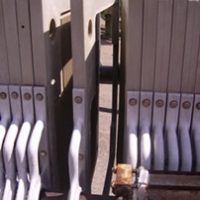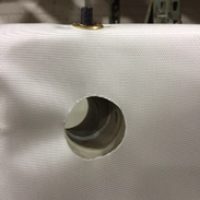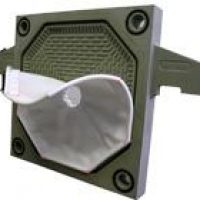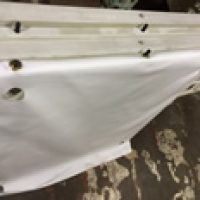The Plate and Frame Press is the most fundamental design and the oldest type of Filter Press. The design is a skeleton made of metal that holds and clamps the filter plates together to form a pressure chamber. This clamping is done by either an old style wheel crank or more modernly with a hydraulic pump and cylinder (either manual or automatic). The plates are made out of a variety of metal such as cast iron, aluminum or plastics, with the most common being polypro.
The plate and frame design is to have a solid plate covered by a filter cloth and a hollow frame in between each plate. The slurry is pumped into one or more of the corner holes and it travels into each frame before filtering through the cloth. The clean filtered solution travels across the drainage service of the solid plate and into one or more of the corner holes that are not being used for the slurry feed. This clean solution travels to the discharge plumbing to customer’s tanks, drain or process. Once these hollow frames are full of solids, no more slurry feed can come into the filter press and it is time to open the press and knock out the solids.
The advantage of this design is that different thicknesses of frames can be used for a variety of cake thicknesses. This allows flexibility in the amount of filtered solids that can be produced per batch. One disadvantage is the fact that feeding the corner and flowing through a small opening into the frame can cause plugging leaving one frame full and another empty. The uneven pressure in the one frame can cause the solid plate to blow out its drainage surface and destroy the plate. The other disadvantage is this style of plate is what we call non-gasketed. The cloth that hangs over the plate serves as a gasket between the plates, but often the cloth wicks liquid under pressure or out and out leaks solution between the plates. Quite often these style of filter presses are mounted over grating or drainage pits to collect the leaked liquid.



The modern version of a Filter Press is to use plates that have recesses in them. When these plates are pushed together, they form the cavity (replacement for the hollow frames of the plate and frame design) for solids to collect in. The filter press skeleton is made the same way as a plate and frame where the plates hang on a steel frame and are clamped together by a hydraulic cylinder and pump (the smaller size can use a manual version while the larger ones are normally automatic).
These recessed plates are normally manufactured out of polypro and come in gasketed and non-gasketed types. The gaskteted plate is normally center feed with rubber gaskets around the corner holes and the solids cavity.
The feed slurry is fed through the center feed and the solids collect in the plate cavity, while the filtered liquid passes through the cloth to the drainage surface. The filtration cloth has a rope sewn in it and it pounds into the groove in the filtration area to hold it into place. From the drainage surface, the liquid flows to the corner holes where it goes into the discharge piping and then to the process tanks or drain.
The recessed plate is also manufactured in a non-gasketed design. The plates and its application are the same as a gasketed plate, except that it has no gaskets. The filtration cloth sticks out between the plates and often has a latex coating on the sealing surface to try and decrease or stop cloth wicking and leakage.
One of the Advantages of a Recessed Plate is the ability to feed a large center hole which easily and quickly fills the cavities without clogging and damaging plates because of unequal pressure. The other advantage is the dry operation because of the gaskets or the latex edging on the cloth of a non-gasketed plate. Also, with the recessed plate, when you open the filter press and slide the plates, the cake falls out in most cases because it’s not held in by a 4-sided frame.
The disadvantages are the restrictions of the cake thickness based on the recessed area. It can’t be changed by adding a thicker or thinner frame like in a plate and frame unit. The cloth change out is also a little more difficult than the simple drape over on a plate and frame.
In summary, most modern Filter Presses use recessed plates because of the advantages of dryer operations and the ability to feed the larger center hole. Plate and frame units are used more in production applications, like in the chemical industry, where different processes require different cake thicknesses and a frame change out easily accomplishes this.





Air operated diaphragm pumps are used with filter presses to pump sludge from the bottom of the sludge holding tank into the filter press. These pumps are ideal because they can handle the slurry which is generally about the consistency of a milkshake.
The diaphragm pump usually starts out slowly and gradually ramps up. Once the pump starts to slow back down, (30-60 seconds between thrusts), it is usually an indicator that the filter press is full. At this point, the feed pump should be turned off and the valves on the filter press closed as the operator prepares to operate the air-blow-down process.
The diaphragm pump can be manually turned up or an Automatic Pump Control system may be added. This starts the pump at 25 psi, then moves up to 50, 75 and finally 100 psi which is standard operating pressure for the pump.
Met-Chem provides diaphragm pumps in the following sizes: 1”, 1.5”, 2” and 3”. The material of construction ranges from cast iron, aluminum, polypro or stainless steel.
With the purchase of a new Met-Chem filter press, Met-Chem can mount your air operated diaphragm pump to the legs of your filter press. This option also includes a flex hose that connects the outlet of the diaphragm pump to the center feed pipe, an air filter, a regulator, and an oiler. We can also provide a mounted diaphragm pump for your existing press.
 Automatic Pump System Control Panel gradually increases the pump pressure up to 100 PSI for standard units. This allows for even filling of the filter chambers.
Automatic Pump System Control Panel gradually increases the pump pressure up to 100 PSI for standard units. This allows for even filling of the filter chambers.The Met-Chem Automatic Pump Control System is used in conjunction with an air operated diaphragm pump to automatically increase the feed pump pressure at predetermined intervals during the filter press filling cycle. If the pump runs at a higher initial pressure, the filter cake will become a packed layer of solids on the filter cloth. This will restrict the flow of the slurry thereby creating a very dense coating of the filter cake. This can cause the cloths to blind off and not allow further filtration. Starting at a lower feed pressure allows a soft layer of slurry particles to be deposited on the filter cloth. This initial layer becomes the filtering media which will enhance the filterability of the incoming slurry.
The automatic pump control system automatically and gradually increases the feed pressure in four stages during the filling cycle. These stages are adjustable to suit your slurry and solids concentration. However, it is commonly set at increments of 25 psi. (25, 50, 75, 100). By monitoring the feed pump flow sensor, during the final pressure stage, the operator will be able to determine the cycle completion.
The Automatic Pump Control System also incorporates a low hydraulic pressure safety shut down the device. If there is not enough hydraulic clamping pressure present, the system will completely shut down, eliminating any possible leaking from between the filter plates.
The pump control system allows your filter press to run at its optimum efficiency creating dryer filter cakes, reducing disposal costs, reducing operator time and increasing the life of your filter cloths and feed pumps.
This system can be incorporated with a new filter press from Met-Chem, a used unit or even your own existing press.
 Met-Chem is pleased to offer our spare parts kit which includes our 5 piece center feed pipe assembly, a head, tail, and 2 intermediate filter press cloths, and 100 foot of gasketing material. These are essential items for the operation of the filter press. A cracked pipe, ripped cloth, or torn gasket can happen anytime and having these items in your stock will ensure you will be back up and running in no time.
Met-Chem is pleased to offer our spare parts kit which includes our 5 piece center feed pipe assembly, a head, tail, and 2 intermediate filter press cloths, and 100 foot of gasketing material. These are essential items for the operation of the filter press. A cracked pipe, ripped cloth, or torn gasket can happen anytime and having these items in your stock will ensure you will be back up and running in no time.
 A center feed pipe assembly on a filter press should be able to last many years the same way any other type of plumbing will. However, if the material of the center feed pipe assembly is not strong enough to handle the corrosiveness of the solution running through the press then the center feed pipe assembly can corrode.
A center feed pipe assembly on a filter press should be able to last many years the same way any other type of plumbing will. However, if the material of the center feed pipe assembly is not strong enough to handle the corrosiveness of the solution running through the press then the center feed pipe assembly can corrode.
For cases of corrosive material or high temperatures, Met-Chem is pleased to offer upgrades from our standard center feed pipe and manifold. We are able to upgrade to CPVC, Carbon Steel, 304 or 316SS Stainless Steel, and Titanium. Met-Chem can also provide additional manifold upgrades such as automatic valves
The center feed pipe is what connects the filter press to the product that needs to be filtered. The center feed pipe assembly consists of five different parts. The first part is the lock nut which fastens on the center feed pipe and connects to the outside of the press. The pipe, which is the second part, goes through the head of the filter and all the way through the head plate of the filter press. The third part of the center feed pipe assembly is a gasket which ensures the assembly is watertight. Next, is the clip nut seat which fastens the assembly to the head plate. This part of the assembly will always stay in place unless you are replacing the assembly or one of its parts. The final part, the cloth clip nut, will be removed often as it is screwed into the cloth clip nut seat after the head cloth is put on the head plate. The cloth clip nut needs to be tightened in order to keep the cloth in place. Met-Chem provides a tool to make this process easier. The Met-Chem Spanner Wrench is a specially designed tool that can be used to loosen and tighten the cloth clip nut when changing the head cloth on a filter press. This tool can be very helpful as the cloth clip, but it has a design that requires a unique tool to tighten and loosen it.
Met-Chem can provide longer legs and a disposal chute on your new filter press. This is especially useful if you are releasing the sludge from the press into a sludge bag or a drum. The chute will direct the sludge directly into your container. If you plan to use a sludge disposal bag, we can add hooks to the chute so that the sludge bag can be hung from the frame of the press.
For some larger presses, we can build a catwalk along with the disposal chute in order to accommodate a roll-off container.


 Sludge Dumpsters are used directly under the filter press to catch the sludge that is released from the filter press during cleaning. The dumpster is on casters for easy mobility. They are also equipped with forklift slats for convenient use with a tow motor. The operator can move the dumpster to a roll-off container with the forklift and then pull the release pin for easy emptying. The dumpster can then be snapped back to the upright position and put back under the filter press.
Sludge Dumpsters are used directly under the filter press to catch the sludge that is released from the filter press during cleaning. The dumpster is on casters for easy mobility. They are also equipped with forklift slats for convenient use with a tow motor. The operator can move the dumpster to a roll-off container with the forklift and then pull the release pin for easy emptying. The dumpster can then be snapped back to the upright position and put back under the filter press.
 If you produce varying size batches of wastewater and subsequently less sludge, or if the overall volume of waste that is generated at your facility has been reduced, you can still utilize your existing filter press. With the purchase of a backer plate, you can alter the holding capacity of your press to meet your individual batch needs.
If you produce varying size batches of wastewater and subsequently less sludge, or if the overall volume of waste that is generated at your facility has been reduced, you can still utilize your existing filter press. With the purchase of a backer plate, you can alter the holding capacity of your press to meet your individual batch needs.
A backer plate provides support to the tail plate so that it can be moved anywhere in the plate pack in order to isolate the chambers between the feed end and the tail plate. If you try to use the tail plate in a different position in the plate pack without the backer plate, you run the risk of damaging the chamber of the tail plate.
There are different kinds of backing plates. Some are made of plastic and look much like a standard plate; we prefer to use ~3/8” thick flat stock steel and cut an outline of a plate. This is clearly visible when placed in the stack so that all around know that the filter press is not at full capacity. This steel backing plate is then painted with the same two-part epoxy coating as the frame of the filter press.
 The start-up and installation options are available with all Met-Chem waste treatment equipment. We can provide full support as you get your system up and running. We have installation technicians and technical representatives that we can send to your facility to make sure the system is running as it should based on the engineering and design.
The start-up and installation options are available with all Met-Chem waste treatment equipment. We can provide full support as you get your system up and running. We have installation technicians and technical representatives that we can send to your facility to make sure the system is running as it should based on the engineering and design.
Our services include but are not limited to:
All units and systems are complete with manuals and telephone support. However, if you need someone to come to your facility, we will be happy to quote you on that as well.
Met-Chem, Inc.
837 East 79th St.
Cleveland, OH 44103
Phone: (216) 881-7900
Email: info@metchem.com
Copyright © Met-Chem, Inc